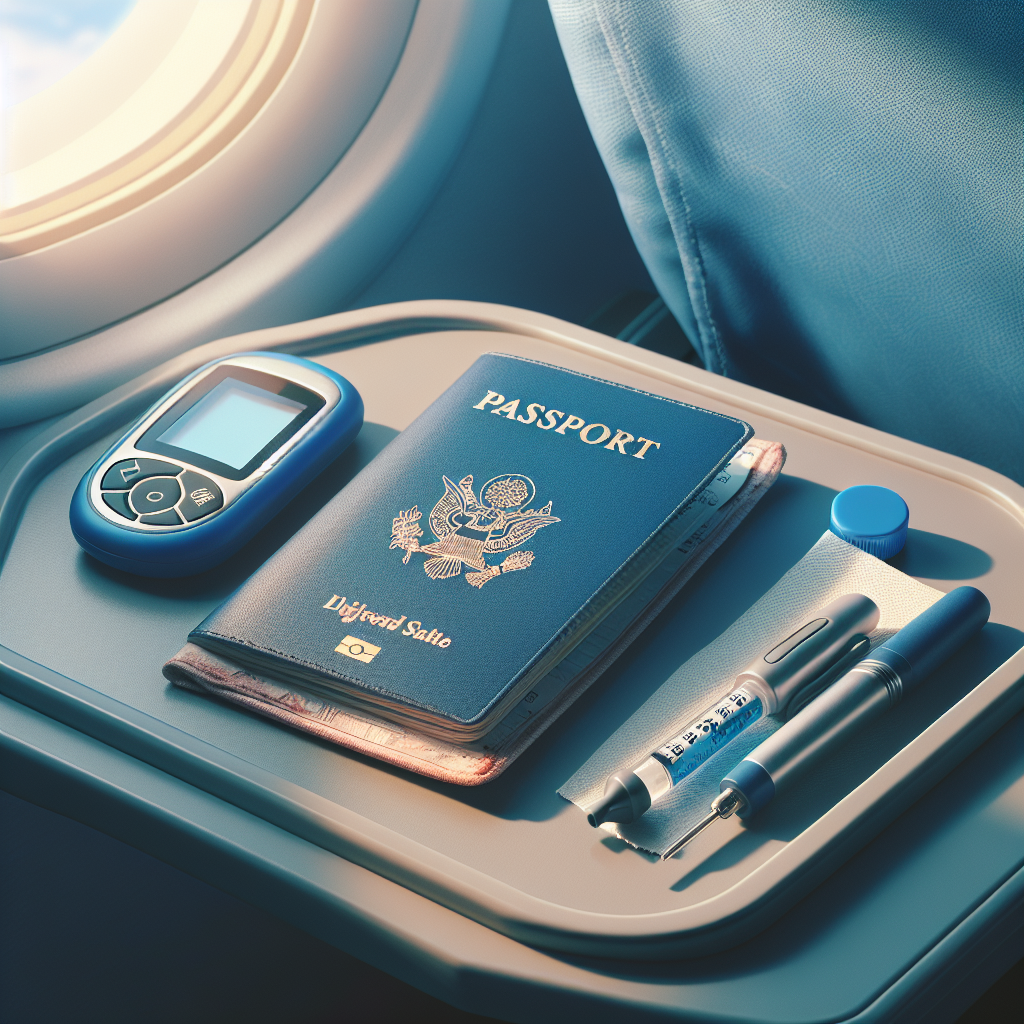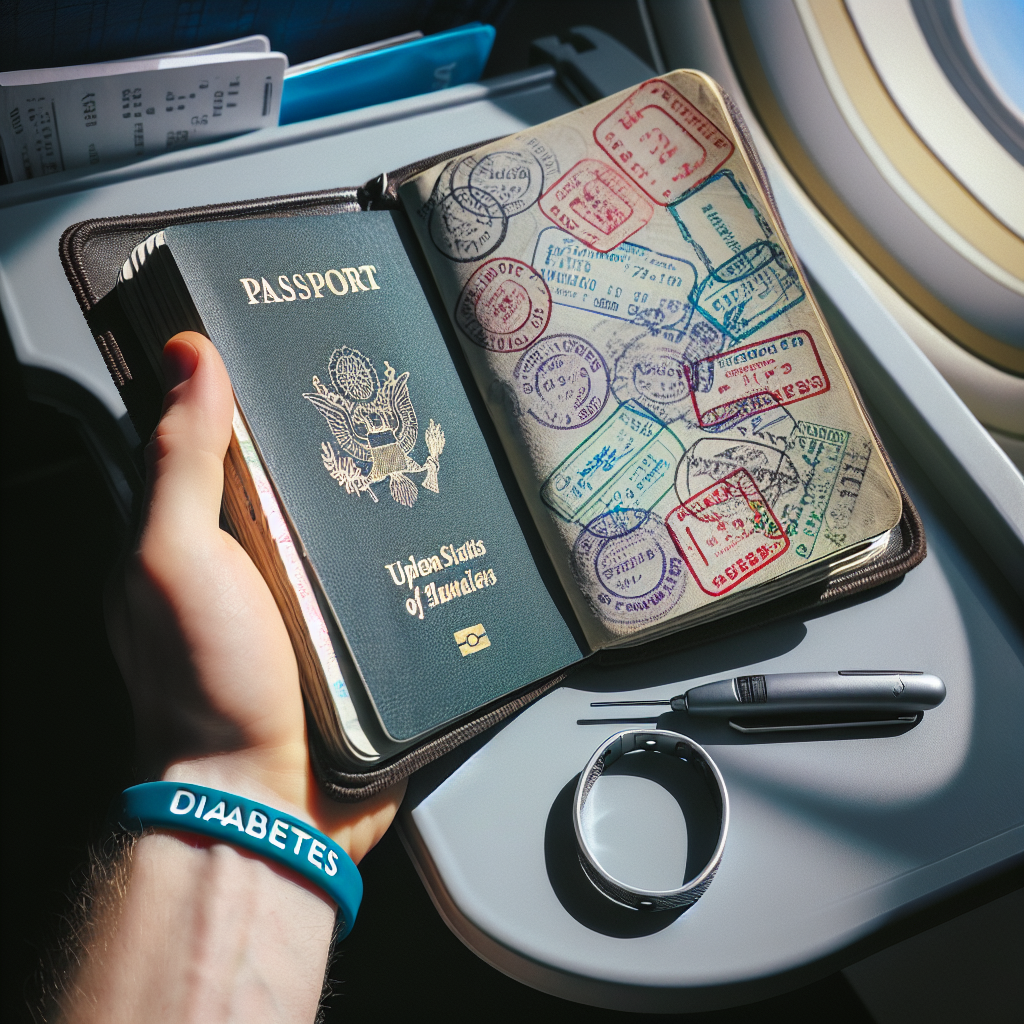Flying can have an impact on various aspects of our health, including diabetes. As you soar through the skies, it’s essential to be aware of how this mode of transportation can affect your blood sugar levels, medication schedules, and overall well-being. In this article, we will explore the specific ways in which flying can impact individuals with diabetes and provide you with helpful tips to ensure a safe and comfortable journey. Whether you’re a frequent flyer or planning your next adventure, understanding the effects of flying on diabetes management is crucial for maintaining a healthy and enjoyable travel experience.

Changes in Blood Sugar Levels
Effect of altitude on blood sugar levels
Flying at high altitudes can have an impact on blood sugar levels, especially for individuals with diabetes. The decrease in cabin pressure at higher altitudes can make blood sugar levels drop. This occurs because when the pressure decreases, the oxygen levels in the blood decrease as well, which can affect insulin absorption and utilization.
On the other hand, some studies have shown that certain individuals might experience elevated blood sugar levels during flights. The reasons for this increase can vary, including stress, lack of physical activity, or changes in meal timings. Understanding the effects of altitude on blood sugar levels is important for individuals with diabetes to effectively manage their condition during air travel.
Managing blood sugar levels during flight
To manage blood sugar levels during a flight, it is crucial to monitor your glucose levels regularly. Use a blood glucose monitor to check your levels before, during, and after the flight. Carry enough testing supplies, such as test strips and lancets, to ensure you can monitor your blood sugar as needed.
Balancing food intake and insulin administration is also essential during flights. Consider consulting with a healthcare professional to determine the appropriate meal and medication timing for your specific travel plans. It may be necessary to adjust your insulin dosage according to the anticipated changes in your routine.
Additionally, staying hydrated during the flight is crucial to maintaining stable blood sugar levels. Drink water regularly and avoid excessive consumption of sugary drinks or alcohol, as they can affect blood sugar control. Remember to carry a refillable water bottle and ask the flight attendants for refills as needed.
Travel Considerations for People with Diabetes
Planning for a diabetic-friendly trip
When planning a trip, it is important for individuals with diabetes to consider their unique needs. Research and identify destinations that have access to medical facilities in case of emergencies. This becomes especially crucial if traveling to remote or unfamiliar locations.
It is also important to inform your travel companions about your diabetes and educate them on how to help in case of emergencies. Consider carrying a medical ID or bracelet to alert others of your condition in the event of an emergency.
Packing diabetes supplies and medications
Before any trip, ensure that you have an ample supply of diabetes supplies and medications. Pack extra insulin, test strips, glucose tablets, and any other medical supplies you may need. It’s wise to pack these supplies in your carry-on luggage to ensure they are always accessible.
If you are traveling to a different time zone, pack extra medication to account for potential delays or changes in your medication schedule. Splitting supplies between your carry-on and checked luggage can also be beneficial in case of lost or misplaced bags.
Managing insulin and other medications during travel
When traveling with insulin, it is important to consider temperature control. Insulin should be stored at proper temperatures to maintain its effectiveness. Use a travel cooler bag or a small thermos with ice packs to keep insulin cool during the journey. Avoid placing insulin directly on ice or allowing it to freeze.
If you are carrying other medications, ensure that they are properly labeled and in their original packaging. This will help prevent any issues at airport security checkpoints.
Ensuring proper nutrition during the journey
Maintaining a healthy diet while traveling can be a challenge, particularly with the limited food options available during flights and in airports. Plan ahead and pack diabetic-friendly snacks, such as nuts, low-sugar protein bars, or fresh fruits, to ensure you have nutritious options available.
If you require a special meal due to your dietary needs, make sure to inform the airline in advance. They can often accommodate special requests such as diabetic-friendly meals. However, it’s always a good idea to have backup snacks in case the provided options are not suitable.
Effects of Cabin Pressure on Insulin
Understanding the impact of cabin pressure on insulin
Cabin pressure changes during air travel can affect the way insulin works in the body. As the aircraft ascends to higher altitudes, the cabin pressure decreases, which in turn affects the pressure inside the insulin vials or pens. This change in pressure can cause air bubbles to form, potentially affecting the accuracy and potency of insulin doses.
Additionally, the decrease in cabin pressure can alter the absorption rate of insulin in the body. The lower oxygen levels at high altitudes can affect the body’s insulin sensitivity and lead to fluctuations in blood sugar levels. Understanding these effects can help individuals with diabetes take necessary precautions to ensure optimal insulin management during air travel.
Precautions to handle insulin during air travel
To mitigate the impact of cabin pressure on insulin, it is advisable to pack insulin in your carry-on luggage, along with cool packs or a travel cooler bag to maintain appropriate temperature control. However, avoid placing insulin directly on ice or allowing it to freeze, as extreme temperatures can compromise its effectiveness.
It is also helpful to carry a backup insulin supply in case of any unforeseen circumstances, such as delays or lost luggage. Having extra insulin readily available ensures that you can address any issues that may arise during your journey.
Managing Stress and Jet Lag
Stress management strategies for travelers with diabetes
Traveling, especially air travel, can be stressful for anyone. For individuals with diabetes, stress can have an impact on blood sugar levels. To manage stress during travel, consider incorporating stress-reducing activities into your routine, such as deep breathing exercises, meditation, or listening to calming music.
Communication is key during travel, so make sure to inform flight attendants or fellow travelers of your condition in case you need assistance or support. Having a support system in place can help alleviate stress and provide peace of mind throughout your journey.
Minimizing the impact of jet lag on blood sugar control
Jet lag occurs when traveling across multiple time zones, disrupting your body’s internal clock and potentially affecting blood sugar control. To minimize the impact of jet lag, gradually adjust your meal and medication timings leading up to your flight. This will help your body gradually adapt to the new time zone.
It is also important to stay hydrated during the flight and upon arrival at your destination to support your body’s natural functions. Avoid excessive caffeine consumption and try to maintain a regular sleep schedule to help regulate blood sugar levels.

Managing Hydration
Importance of staying hydrated during a flight
Staying hydrated while traveling is essential, especially during flights. The low humidity levels in the aircraft cabin can lead to dehydration, which can have an impact on blood sugar control. It is crucial for individuals with diabetes to maintain proper hydration to avoid complications or fluctuations in blood sugar levels.
Tips for managing hydration while traveling with diabetes
To manage hydration during a flight, it is important to drink water regularly. Carry a refillable water bottle and ask flight attendants for refills as needed. Avoid excessive consumption of sugary drinks or alcohol, as they can lead to both dehydration and blood sugar fluctuations.
In addition to drinking water, it is important to moisturize your skin to prevent dryness. Pack a travel-sized moisturizer and apply it throughout the journey to keep your skin hydrated.
Adjusting Meal and Medication Timing
Understanding time zone changes and their effect on diabetes management
When traveling across different time zones, adjusting meal and medication timings can be crucial for individuals with diabetes. Sudden changes in time zones can disrupt your regular routine and affect blood sugar control, especially if you’re taking insulin or other medications that require specific timing.
Understanding how time zone changes will affect your diabetes management is key to maintaining stable blood sugar levels. Consult with your healthcare professional before your trip to discuss the appropriate adjustments to your meal and medication schedule.
Tips for adjusting meal and medication timing during travel
To adjust meal and medication timings during travel, gradually shift your schedule leading up to your trip. Start adjusting your routine a few days before departure, shifting meal and medication times by small increments each day. This will help your body gradually adapt to the new time zone and minimize disruptions to your blood sugar control.
Consider setting alarms or reminders on your phone or other devices to prompt you to adhere to your adjusted schedule. Being proactive and sticking to your new routine will help you manage your diabetes effectively while traveling.

Airport Security and Diabetes Supplies
Navigating airport security with diabetes supplies
Airport security can be a source of concern for individuals with diabetes, as diabetes supplies may need special considerations during security screenings. It is important to inform security personnel that you have diabetes and are carrying medical supplies before going through the screening process.
Make sure your diabetes supplies, such as insulin, syringes, or insulin pens, are properly labeled to avoid any confusion or unnecessary delays. Consider having a note from your healthcare professional explaining your medical condition and the necessity of carrying diabetes supplies and medications.
Carrying necessary documentation
When traveling with diabetes supplies, it is wise to have necessary documentation readily available. This can include a prescription from your healthcare professional for insulin and other medications, as well as a letter explaining your condition and the need for specific supplies.
If you are traveling internationally, research the specific requirements and regulations of your destination country regarding the transportation of diabetes supplies. Some countries may have specific rules or restrictions that you need to be aware of to avoid any issues at customs.
Tips to ease the security process
To ease the security process, consider using clear plastic bags to separate your diabetes supplies and medications to make them easily visible during the screening. This helps security personnel clearly identify the items and prevents any unnecessary handling or confusion.
Additionally, it is always helpful to arrive at the airport early to allow ample time for the security process. Being prepared and organized with your diabetes supplies and necessary documentation will help streamline the screening process and reduce stress or anxiety.
Precautions for Long-Haul Flights
Challenges posed by long-haul flights for people with diabetes
Long-haul flights pose unique challenges for individuals with diabetes, including extended periods of sitting, limited mobility, and potential disruptions to regular meal and medication timings. These factors can impact blood sugar control and increase the risk of blood clots or deep vein thrombosis.
Strategies to minimize health risks during long flights
To minimize health risks during long-haul flights, it is important to stay active and encourage movement whenever possible. Take short walks up and down the aisle, stretch your legs while seated, or perform simple exercises to promote blood circulation.
Additionally, try to maintain your regular meal and medication timings as closely as possible, even when crossing multiple time zones. This consistency helps regulate blood sugar levels and support your body’s natural rhythm.
Consider wearing compression socks or stockings to promote blood flow and reduce the risk of blood clots. These can be particularly beneficial during long flights to counteract the effects of prolonged sitting.

Exercise Opportunities in Transit
Making use of exercise options during layovers
During layovers, take advantage of the airport facilities to incorporate exercise into your transit time. Many airports now offer walking paths or fitness centers where you can engage in physical activity between flights. Explore the airport and stretch your legs to enhance blood circulation and relieve any stiffness from the previous flight.
If the airport does not have dedicated exercise areas, look for stairs to climb or open spaces where you can walk or perform simple exercises. Even a few minutes of movement can make a difference in helping you stay active during your journey.
Exercising on the plane
Exercising on the plane may be more challenging due to limited space, but there are still options to incorporate movement during the flight. Perform simple stretches while seated, such as ankle rotations, shoulder rolls, or neck stretches. These movements help prevent muscle stiffness and promote blood circulation.
If you have an aisle seat, take advantage of the opportunity to stand up and stretch whenever possible. Use the space near the restrooms or galley to walk or perform stretching exercises. Consult with your healthcare professional to determine appropriate exercises that can be done discreetly without disturbing other passengers.
Support and Resources for Travelers with Diabetes
Utilizing diabetes support networks during travel
When traveling with diabetes, it can be beneficial to connect with diabetes support networks or online communities. These platforms provide a space to share experiences, ask questions, and receive support from individuals who understand the unique challenges of managing diabetes while traveling.
Engaging with these support networks can offer valuable insights, tips, and recommendations from fellow travelers with diabetes. It also helps foster a sense of belonging and a community that understands the specific needs and concerns of individuals managing diabetes during travel.
Accessing resources for diabetes management in different locations
Before traveling to a new location, research the availability of healthcare facilities and diabetes resources in the area. Identify local hospitals, clinics, or pharmacies where you can seek assistance if needed. It is also helpful to have contact information for local diabetes organizations or support groups that may be able to provide additional guidance or resources.
Consider carrying a printed list of emergency contacts, including your healthcare professional’s contact information and any local emergency helpline numbers. This ensures you have the necessary information on hand in case of any medical emergencies or urgent assistance requirements.
By being prepared and knowledgeable about the available resources, you can navigate any unexpected situations and ensure proper diabetes management throughout your travel experience.
In conclusion, flying can have various effects on individuals with diabetes, from changes in blood sugar levels due to altitude and cabin pressure to managing stress, hydration, and meal timings during travel. By understanding and preparing for these effects, individuals with diabetes can have a safer and more enjoyable travel experience. It is crucial to plan ahead, pack necessary supplies, and stay informed about diabetes management resources at your destination. With proper preparation and care, individuals with diabetes can take to the skies and explore the world with confidence.


